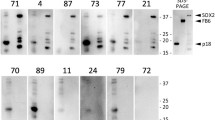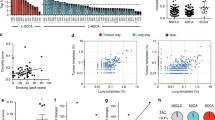Abstract
Glycolipids GM2, GD2, GD3, fucosyl GM1, sialyl Lewis a (sLea) and globo H, and polysialic acid on embryonal NCAM, are cell-surface antigens expressed on small cell lung cancer (SCLC) biopsy specimens. They are all candidates for inclusion in a polyvalent, antibody-inducing vaccine or for adoptive therapy with monoclonal antibodies (mAbs) against SCLC. To identify the minimum optimal combination of target antigens on SCLC and to confirm that antibodies against this combination might be able to mediate complement activation and lysis in the majority of cases, we tested ten SCLC cell lines with fluorescence activated cell sorter (FACS) and complement dependent cytotoxicity (CDC) assays using mAbs against these seven target antigens individually or pooled in different combinations. We find that (1) none of these mAbs demonstrated strong FACS reactivity with more than 6 of the 10 cell lines, (2) no mAb had strong CDC reactivity with more than 4 of the cell lines, (3) when the mAbs were pooled, nine cell lines were strongly positive by FACS and nine cell lines were strongly positive by CDC, and (4) mAbs against GM2, FucGM1, globo H and polysialic acid was the minimum optimal combination for inducing FACS reactivity. The addition of mAbs against sLea, GD2 and GD3 had no additional impact by FACS and only minimal additional impact in CDC assays. H345, the only cell line that had less than 30% CDC with the four mAb pool was strongly positive by FACS. To understand the lack of correlation between FACS and CDC in the case of H345, the ten cell lines were screened for expression of complement resistance factors CD55 and CD59. Three cell lines were strongly positive for CD55 and eight were strongly positive for CD59. Overall, no correlation was seen between expression of either of these factors on the ten cell lines and sensitivity to CDC. In the case of H345 however, complement resistance of H345 is demonstrated to be mediated primarily by CD59, and in the presence of mAb against CD59, the four mAb MEM-43 pool induced strong (94%) CDC. CD59 inhibits membrane attack complex formation but not activation of earlier complement components. Consequently, all ten cell lines are good targets for complement activation by the four antibody pool and for elimination by effector mechanisms including complement mediated inflammation and opsonization. These findings support our plan to develop a tetravalent vaccine against SCLC targeting GM2, fucosyl GM1, globo H and polysialic acid.



Similar content being viewed by others
References
Brezicka FT, Olling S, Nilsson O, Bergh J, Holmgren J, Sorenson S, Yngvason F, Lindholm L (1989) Immunohistological detection of fucosyl-GM1 ganglioside in human lung cancer and normal tissues with monoclonal antibodies. Cancer Res 49(5):1300–1305
Brezicka T, Bergman B, Olling S, Fredman P (2000) Reactivity of monoclonal antibodies with ganglioside antigens in human small cell lung cancer tissues. Lung Cancer 28(1):29–36
Caragine TA, Okada N, Frey AB, Tomlinson SA (2002) Tumor-expressed inhibitor of the early but not late complement lytic pathway enhances tumor growth in a rat model of human breast cancer. Cancer Res 62(4):1110–1115
Chapman PB, Livingston P, Morrison ME, Williams L, Houghton AN (1994) Immunization of melanoma patients with antiidiotype monoclonal antibody bec2 (which mimics GD3 ganglioside): pilot trials using no immunological adjuvant. Vaccine Res 3(2):59–69
Cheresh DA, Rosenberg J, Mujoo K, Hirschowitz L, Reisfeld RA (1986) Biosynthesis and expression of the disialoganglioside GD2, a relevant target antigen on small cell lung carcinoma for monoclonal antibody-mediated cytolysis. Cancer Res 46(10):5112–5118
Cheung NK, Walter EI, Smith-Mensah WH, Ratnoff WD, Tykocinski ML, Medof ME (1988) Decay-accelerating factor protects human tumor cells from complement-mediated cytotoxicity in vitro. J Clin Invest 81(4):1122–1128
Colten HR, Rosen FS (1992) Complement deficiencies. Annu Rev Immunol 10:809–834
Dickler MN, Ragupathi G, Liu NX, Musselli C, Martino DJ, Miller VA, Kris MG, Brezicka FT, Livingston PO, Grant SC (1999) Immunogenicity of a fucosyl-GM1-keyhole limpet hemocyanin conjugate vaccine in patients with small cell lung cancer. Clin Cancer Res 5(10):2773–2779
Giaccone G, Debruyne C, Felip E, Millward M, D’Addario G, Thiberville L, Rome L, Zatloukal P, Legrand C (2004) Phase III study of BEC2/BCG vaccination in limited disease small cell lung cancer (LD-SCLC) patients, following response to chemotherapy and thoracic irradiation (EORTC 08971, the SILVA study). J Clin Oncol (Meeting Abstracts) 22(14_suppl):7020
Helling F, Zhang S, Shang A, Adluri S, Calves M, Koganty R, Longenecker BM, Yao TJ, Oettgen HF, Livingston PO (1995) GM2-KLH conjugate vaccine: increased immunogenicity in melanoma patients after administration with immunological adjuvant QS-21. Cancer Res 55(13):2783–2788
Huntsberger DV, Leaverton P (1970) Statistical inference in the biomedical sciences. Allyn and Bacon Inc., Boston
Jarvis GA, Li J, Hakulinen J, Brady KA, Nordling S, Dahiya R, Meri S (1997) Expression and function of the complement membrane attack complex inhibitor protectin (CD59) in human prostate cancer. Int J Cancer 71(6):1049–1055
Joiner KA (1988) Complement evasion by bacteria and parasites. Annu Rev Microbiol 42:201–230
Komminoth P, Roth J, Lackie PM, Bitter-Suermann D, Heitz PU (1991) Polysialic acid of the neural cell adhesion molecule distinguishes small cell lung carcinoma from carcinoids. Am J Pathol 139(2):297–304
Krug LM, Ragupathi G, Ng KK, Hood C, Jennings HJ, Guo Z, Kris MG, Miller V, Pizzo B, Tyson L, Baez V, Livingston PO (2004) Vaccination of small cell lung cancer patients with polysialic acid or N-propionylated polysialic acid conjugated to keyhole limpet hemocyanin. Clin Cancer Res 10(3):916–923
Krug LM, Ragupathi G, Hood C, Kris MG, Miller VA, Allen JR, Keding SJ, Danishefsky SJ, Gomez J, Tyson L, Pizzo B, Baez V, Livingston PO (2004) Vaccinatin of patients with small cell lung cancer with synthetic fucosyl GM1 conjugated to Keyhole Limpet Hemocyanin (KLH). Clin Cancer Res 10:6094–6102
Ragupathi G, Liu NX, Musselli C, Powell S, Lloyd K, Livingston PO (2005) Antibodies against tumor cell glycolipids and proteins, but not mucins, mediate complement-dependent cytotoxicity. J Immunol 174:5706–5712
Livingston P, Zhang S, Adluri S, Yao TJ, Graeber L, Ragupathi G, Helling F, Fleisher M (1997) Tumor cell reactivity mediated by IgM antibodies in sera from melanoma patients vaccinated with GM2 ganglioside covalently linked to KLH is increased by IgG antibodies. Cancer Immunol Immunother 43(6):324–330
Moffitt MC, Frank MM (1994) Complement resistance in microbes. Springer Semin Immunopathol 15(4):327–344
Nicholson-Weller A, Burge J, Fearon DT, Weller PF, Austen KF (1982) Isolation of a human erythrocyte membrane glycoprotein with decay-accelerating activity for C3 convertases of the complement system. J Immunol 129(1):184–189
Nilsson O, Mansson JE, Brezicka T (1984) Fucosyl-GM1-A ganglioside associated with small cell lung carcinomas. Glycoconjugate 1:43–49
Ragupathi G, Cappello S, Yi SS, Canter D, Spassova M, Bornmann WG, Danishefsky SJ, Livingston PO (2002) Comparison of antibody titers after immunization with monovalent or tetravalent KLH conjugate vaccines. Vaccine 20(7–8):1030–1038
Ragupathi G, Koide F, Sathyan N, Kagan E, Spassova M, Bornmann W, Gregor P, Reis CA, Clausen H, Danishefsky SJ, Livingston PO (2003) A preclinical study comparing approaches for augmenting the immunogenicity of a heptavalent KLH-conjugate vaccine against epithelial cancers. Cancer Immunol Immunother 52(10):608–616
Ragupathi G, Livingston PO, Hood C, Gathuru J, Krown SE, Chapman PB, Wolchok JD, Williams LJ, Oldfield RC, Hwu WJ (2003) Consistent antibody response against ganglioside GD2 induced in patients with melanoma by a GD2 lactone-keyhole limpet hemocyanin conjugate vaccine plus immunological adjuvant QS-21. Clin Cancer Res 9(14):5214–5220
Ragupathi G, Meyers M, Adluri S, Howard L, Musselli C, Livingston PO (2000) Induction of antibodies against GD3 ganglioside in melanoma patients by vaccination with GD3-lactone-KLH conjugate plus immunological adjuvant QS-21. Int J Cancer 85(5):659–666
Ragupathi G, Slovin S, Adluri S, Sames D, Kim IJ, Kim HM, Spassova M, Bornmann W, Lloyd KO, Scher HI, Livingston PO, Danishefsky SJ (1999) A fully synthetic globo H carbohydrate vaccine induces a focused humoral response in prostate cancer patients: a proof of principle. Angew Chem Int Ed 38(4):563–566
Sakuma T, Kodama K, Hara T, Eshita Y, Shibata N, Matsumoto M, Seya T, Mori Y (1993) Levels of complement regulatory molecules in lung cancer: disappearance of the D17 epitope of CD55 in small-cell carcinoma. Jpn J Cancer Res 84(7):753–759
Scheidegger EP, Lackie PM, Papay J, Roth J (1994) In vitro and in vivo growth of clonal sublines of human small cell lung carcinoma is modulated by polysialic acid of the neural cell adhesion molecule. Lab Invest 70(1):95–106
Slovin SF, Ragupathi G, Adluri S, Ungers G, Terry K, Kim S, Spassova M, Bornmann WG, Fazzari M, Dantis L, Olkiewicz K, Lloyd KO, Livingston PO, Danishefsky SJ, Scher HI (1999) Carbohydrate vaccines in cancer: immunogenicity of a fully synthetic globo H hexasaccharide conjugate in man. Proc Natl Acad Sci 96:5710–5715
Zhang S, Cordon-Cardo C, Zhang HS, Reuter VE, Adluri S, Hamilton WB, Lloyd KO, Livingston PO (1997) Selection of tumor antigens as targets for immune attack using immunohistochemistry: I. Focus on gangliosides. Int J Cancer 73(1):42–49
Zhang S, Zhang HS, Cordon-Cardo C, Ragupathi G, Livingston PO (1998) Selection of tumor antigens as targets for immune attack using immunohistochemistry: protein antigens. Clin Cancer Res 4(11):2669–2676
Zhang S, Zhang HS, Cordon-Cardo C, Reuter VE, Singhal AK, Lloyd KO, Livingston PO (1997) Selection of tumor antigens as targets for immune attack using immunohistochemistry: II. Blood group-related antigens. Int J Cancer 73(1):50–56
Author information
Authors and Affiliations
Corresponding author
Additional information
Supported by grants from the NIH (PO1CA33049), and the Lawrence and Selma Ruben Foundations.
Rights and permissions
About this article
Cite this article
Livingston, P.O., Hood, C., Krug, L.M. et al. Selection of GM2, fucosyl GM1, globo H and polysialic acid as targets on small cell lung cancers for antibody mediated immunotherapy. Cancer Immunol Immunother 54, 1018–1025 (2005). https://doi.org/10.1007/s00262-005-0663-8
Received:
Accepted:
Published:
Issue Date:
DOI: https://doi.org/10.1007/s00262-005-0663-8




